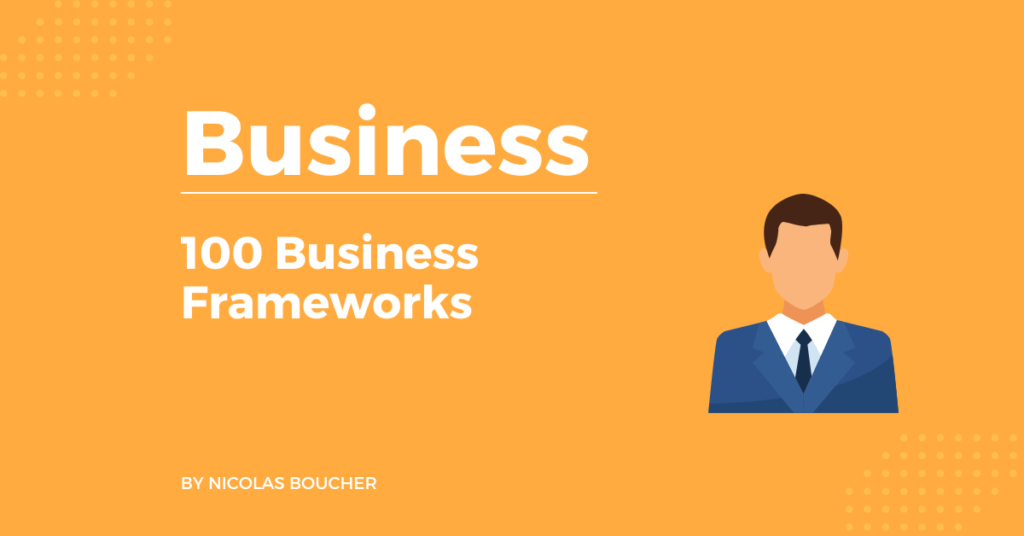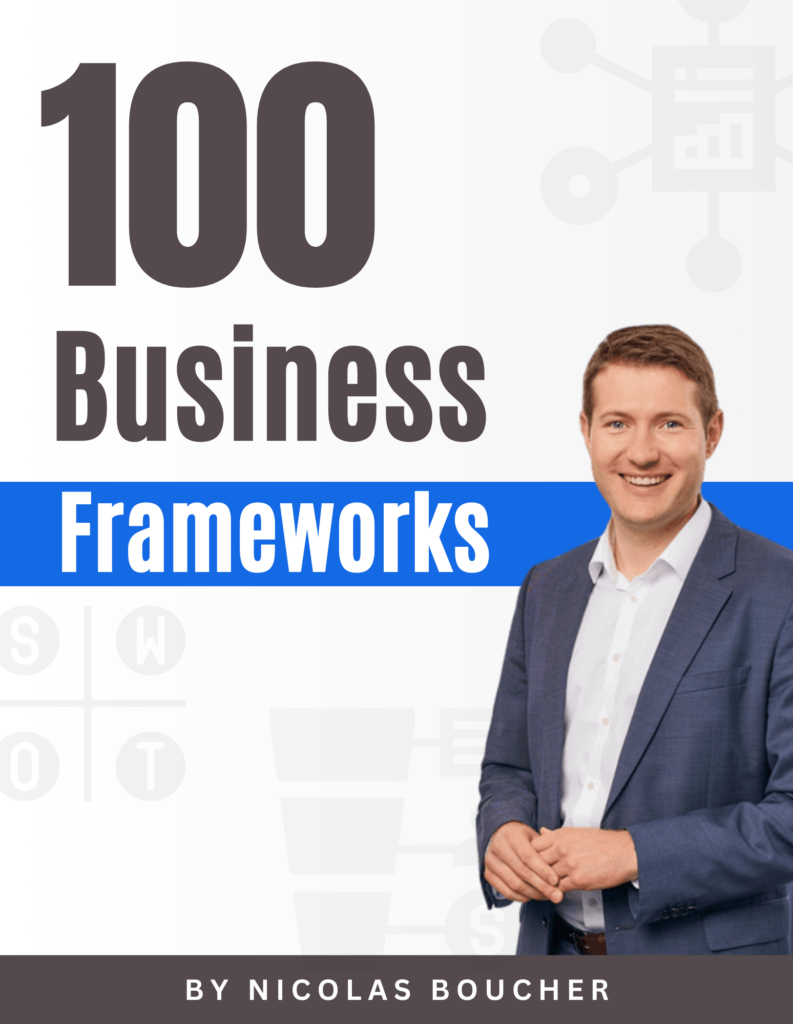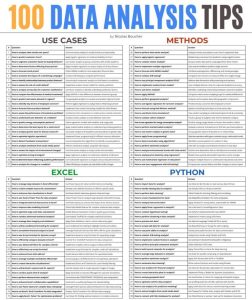Running a business isn’t easy. Every day brings new challenges, and making the right decisions can feel overwhelming. That’s where business frameworks come in—they’re not just abstract concepts or fancy terms.
Think of them as practical tools that help you cut through the noise, see things clearly, and take action that really makes a difference.
Why Are Business Frameworks Important?
Guiding Strategic Thought
Business frameworks provide a structured approach to analyzing problems and identifying opportunities. By breaking down larger issues into smaller, more manageable parts, they make it easier to focus on specific aspects, enhancing strategic planning and decision-making.
Enabling Actionable Insights
Frameworks are powerful analytical tools that transform raw data into actionable insights. These insights help businesses identify clear steps that bridge the gap between strategy and execution, ensuring that plans are not just theoretical but practical and implementable.
Providing a Common Language
A significant benefit of business frameworks is that they create a common language within a team or organization. This shared understanding facilitates better communication, ensuring that everyone is on the same page, which leads to more focused and productive discussions.
Adaptability and Versatility
Most business frameworks are designed to be flexible and adaptable to different business sizes, types, or industries. This versatility ensures that they remain relevant and useful across various contexts, whether for a startup or a multinational corporation.
Risk Mitigation
Frameworks help identify potential risks and threats early by offering a comprehensive view of the business environment. This proactive approach enables businesses to develop strategies that mitigate risks, protect their interests, and ensure long-term stability.
Facilitating Continuous Improvement
Many business frameworks are iterative, meaning they are intended to be used repeatedly. This iterative nature allows businesses to learn from each implementation, continually refining their strategies for better outcomes.
Aligning Teams and Resources
Business frameworks play a crucial role in aligning various resources—whether human, financial, or material—with the organization’s goals. By providing a clear roadmap, they ensure that every part of the business works toward a unified objective, increasing the likelihood of success.
Download your copy of the 100 Business Frameworks eBook now!What’s Inside The eBook?
Inside the eBook, you will find 100 different business frameworks divided into four parts. There are frameworks on Strategic Management, Project Management, Process & Quality Management, and Analysis & Decision Making.
Here are all of the frameworks included:
Strategic Management
- Chapter 1: SWOT Analysis
- Chapter 2: 4P’s Marketing Mix
- Chapter 3: BCG Matrix
- Chapter 4: PESTLE Analysis
- Chapter 5: Balanced Scorecard
- Chapter 6: Value Chain Analysis
- Chapter 7: Blue Ocean Strategy
- Chapter 8: Scenario Planning
- Chapter 9: Ansoff Matrix
- Chapter 10: GE McKinsey Matrix
- Chapter 11: Porter’s Five Forces
- Chapter 12: Kotter’s 8-Step Change Model
- Chapter 13: VRIO Framework
- Chapter 14: Hofer’s Product/Market Matrix
- Chapter 15: Portfolio Analysis
- Chapter 17: Lifecycle Analysis
- Chapter 18: Competing Values Framework (CVF)
- Chapter 19: Resource-Based View (RBV)
- Chapter 20: Bowman’s Strategy Clock
- Chapter 21: The Perceptual Map
- Chapter 22: Technology Adoption Lifecycle
- Chapter 23: McKinsey 7S Framework
- Chapter 24: SOAR Analysis
- Chapter 25: Tipping Point Leadership
Project Management
- Chapter 26: Gantt Chart
- Chapter 27: Critical Path Method (CPM)
- Chapter 28: Agile Methodology
- Chapter 29: Waterfall Methodology
- Chapter 30: RACI Matrix
- Chapter 31: Burn-Down Charts
- Chapter 32: Kanban Boards
- Chapter 33: Outsourcing Decision Matrix
- Chapter 34: Mind Mapping
- Chapter 35: MOST Analysis
- Chapter 36: OSCAR Coaching Model
- Chapter 37: Eisenhower Matrix
- Chapter 38: Johari Window
- Chapter 39: Scrum Framework
- Chapter 40: SAFe (Scaled Agile Framework)
- Chapter 41: PDCA (Plan-Do-Check-Act)
- Chapter 42: Design Thinking
- Chapter 43: Activity Network Diagram
- Chapter 44: House of Quality
- Chapter 45: Single Minute Exchange of Die (SMED)
- Chapter 46: 8D Report
- Chapter 47: SIPOC
- Chapter 48: Value Stream Mapping
- Chapter 49: Prince2 Methodology
- Chapter 50: V2MOM
- Process & Quality Management
- Chapter 51: Lean Management
- Chapter 52: Fishbone Diagram
- Chapter 53: Pareto Analysis
- Chapter 54: OKR (Objectives and Key Results)
- Chapter 55: MoSCoW Method
- Chapter 56: Force Field Analysis
- Chapter 57: Six Sigma
- Chapter 58: Theory of Constraints
- Chapter 59: SERVQUAL
- Chapter 60: Double Loop Learning
- Chapter 61: Benchmarking
- Chapter 62: Gap Analysis
- Chapter 63: Kano Model
- Chapter 64: TOWS Matrix
- Chapter 65: Cost-Benefit Analysis
- Chapter 66: Monte Carlo Simulation
- Chapter 67: Customer Journey Mapping
- Chapter 68: Venn Diagram
- Chapter 69: Kotler’s 4C Model
- Chapter 70: Risk Matrix
- Chapter 71: 5 Whys
- Chapter 72: Conjoint Analysis
- Chapter 73: Non-Quality Costs Management
- Chapter 74: Real Options Valuation
- Chapter 75: Chapter: Total Quality Management (TQM)
Analysis & Decision Making
- Chapter 76: Issue Trees
- Chapter 77: SMART Objectives
- Chapter 78: OODA Loop
- Chapter 79: Financial Ratios
- Chapter 80: CAGE Distance Framework
- Chapter 81: Customer Segmentation
- Chapter 82: Prioritization Matrix
- Chapter 83: PVM Analysis
- Chapter 84: Decision Trees
- Chapter 85: Experience Curve
- Chapter 86: DuPont Analysis
- Chapter 87: DESTEP Analysis
- Chapter 88: Decision Balance Sheet
- Chapter 89: Critical Success Factor (CSF) Analysis
- Chapter 90: Diffusion of Innovations
- Chapter 91: Business Process Reengineering (BPR)
- Chapter 92: Theory of Constraints (TOC)
- Chapter 93: Multi-Criteria Decision Analysis (MCDA)
- Chapter 94: Most Significant Change (MSC) Technique
- Chapter 95: Cost-Effectiveness Analysis (CEA)
- Chapter 96: Heuristic Evaluation
- Chapter 97: Anchoring and Adjustment Heuristic
- Chapter 98: Cognitive Mapping Technique
- Chapter 99: Delphi Method
- Chapter 100: Cynefin Framework
Preview of Business Frameworks
The 100 Business Frameworks eBook covers frameworks on Strategic Management, Project Management, Process & Quality Management, and Analysis & Decision Making.
Download your copy of the 100 Business Frameworks eBook now!Here are 5 of the 100 covered inside the book:
#1: BCG Matrix
Definition
The BCG Matrix, or Boston Consulting Group Growth-Share Matrix, is a strategic tool designed to help organizations categorize and prioritize different business units or product lines by evaluating their market growth rate and relative market share. The matrix consists of four quadrants: Stars, Cash Cows, Question Marks, and Dogs.
History
The BCG Matrix was introduced by the Boston Consulting Group in the early 1970s, specifically by BCG founder Bruce Henderson. It was initially created to help corporations analyze their business units or product lines to allocate resources effectively and attain a balance in the portfolio, ensuring sustainability and profitability in the long term.
How to Use the BCG Matrix
Step 1: Plotting the Matrix
- Define the market and identify all products or business units to be plotted.
- Determine the relative market share and market growth rate for each, placing them on the matrix.
Step 2: Analyze Quadrants
- Stars: High market growth and high market share. May need investment to sustain growth.
- Cash Cows: Low market growth but high market share. Generate steady cash flow.
- Question Marks: High market growth but low market share. Potential stars or failures.
- Dogs: Low market growth and low market share. Consider discontinuation.
Step 3: Develop Strategies
- Decide on how to allocate resources among business units.
- Identify units to invest in, to maintain, or to divest.
Practical Example
Imagine a company that manufactures a range of electronic products.
- Stars: Their innovative smart home devices are gaining rapid market share in a growing market.
- Cash Cows: Their well-established line of kitchen appliances has a dominant market share but slow growth.
- Question Marks: A newly introduced line of wearables is growing but has not captured significant market share.
- Dogs: Their older models of smartphones have a low market share and are in a declining market.
This analysis helps the company decide where to invest, perhaps to convert question marks into stars and ensure cash cows continue to provide steady income while possibly divesting dogs.
Pro Tips
- Data Accuracy: Ensure accurate and relevant data to accurately plot the matrix.
- Dynamic Approach: The matrix should be updated regularly to reflect changes in the market and the relative positions of business units.
- Consider Other Factors: While allocating resources, also consider factors like potential synergies between units and future market trends.
Main Takeaways
- The BCG Matrix allows businesses to visualize and evaluate the strategic position of their product portfolio in the market.
- Through effective categorization, organizations can make informed decisions regarding investment and resource allocation across different business units.
- Continual revision and analysis using the BCG Matrix are crucial to adapting to evolving markets and ensuring sustained business growth.
#2: McKinsey 7S Framework
Definition
The McKinsey 7S Framework is a management model developed to diagnose and optimize the holistic performance of an organization. It emphasizes the interconnected nature of various organizational elements and asserts that they must be aligned for success. The seven “S” components are: Strategy, Structure, Systems, Shared Values, Skills, Style, and Staff.
History
The 7S Framework was developed in the early 1980s by Tom Peters and Robert Waterman, two consultants at McKinsey & Company. They introduced the model in their book “In Search of Excellence,” which highlighted the importance of coordination between soft and hard organizational elements.
How to Use the McKinsey 7S Framework
Step 1: Understand the Seven Elements
- Strategy: The plan devised to maintain and build a competitive advantage.
- Structure: The way an organization arranges its hierarchy and business units.
- Systems: The daily processes and procedures used to get work done.
- Shared Values: The core values of the company are reflected in the corporate culture and general work ethic.
- Skills: The organization’s core competencies and capabilities.
- Style: The leadership approach of top management and the organization’s overall operating approach.
- Staff: The organization’s personnel categories, including both leadership and rank-and-file.
Step 2: Analyze the Current State
- Assess each of the seven elements in your organization’s current state. This provides a snapshot of where the organization stands.
Step 3: Identify the Desired State
- Envision where you want the organization to be in terms of each of the 7S elements.
Step 4: Identify Gaps and Inconsistencies
- Compare the current state with the desired state and note discrepancies.
Step 5: Implement Changes
- Based on the gaps identified, initiate changes to align the seven elements and achieve the desired state.
Practical Example
Consider a tech startup aiming to transition from a small team to a mid-sized organization:
- Strategy: Transition from rapid innovation to sustainable growth.
- Structure: From a flat hierarchy to a more departmentalized structure.
- Systems: Implement more formalized reporting and monitoring systems.
- Shared Values: While maintaining the entrepreneurial spirit, emphasize the importance of consistency and reliability.
- Skills: In addition to tech skills, focus on managerial and operational skills.
- Style: Leadership might shift from a very hands-on approach to a more delegative style.
- Staff: Expand teams, introduce middle management, and diversify roles.
Pro Tips
- Balance Between Soft and Hard Elements: While hard elements (Strategy, Structure, Systems) are crucial, do not underestimate the soft elements (Shared Values, Skills, Style, Staff) as they often drive the organization’s character and flexibility.
- Iterative Process: Organizations evolve, and the 7S elements might require periodic reassessment and realignment.
- Stakeholder Engagement: Ensure engagement from all levels of the organization when analyzing and implementing changes.
Main Takeaways
- The McKinsey 7S Framework offers a holistic view of an organization, emphasizing the interconnectedness of its components.
- Aligning all seven elements is crucial for organizational effectiveness and achieving strategic objectives.
- Regularly reviewing and adjusting the elements ensures that the organization remains agile and responsive to changing environments.
#3: RACI Matrix
Definition
The RACI Matrix, sometimes referred to as the Responsibility Assignment Matrix (RAM), is a tool used to clarify roles and responsibilities in processes, projects, or teams. The acronym RACI stands for Responsible, Accountable, Consulted, and Informed.
History
The origins of the RACI matrix are not attributed to a single individual or moment in time, but its principles have been used in business and project management for many decades. The matrix has become a standard tool in many organizational settings, particularly in projects where clarity of roles is crucial.
How to Use the RACI Matrix
Step 1: Identify Work Processes or Tasks
- List down all the tasks, activities, or processes that need clarity of roles.
Step 2: Identify Roles or Participants
- List all the roles or individuals involved in the project or process.
Step 3: Assign Responsibility Codes
- For each task and role intersection, use the RACI definitions:
- Responsible (R): Who is completing the task? There can be multiple Rs.
- Accountable (A): Who makes decisions and takes ownership? There should be only one A for each task.
- Consulted (C): Who do we need input from before proceeding? This is typically a two-way communication.
- Informed (I): Who needs to be kept informed about progress or decisions? This is typically a one-way communication.
Step 4: Review and Adjust
- Once the matrix is filled out, review it with the team or stakeholders to ensure everyone agrees and understands their roles.
Practical Example
In a software development project:
- Tasks might include Requirement Gathering, System Design, Coding, and Testing.
- Roles might include Business Analyst, System Architect, Developer, and QA Tester.
- The Business Analyst might be Responsible for Requirement Gathering, the System Architect Accountable for System Design, the Developer Responsible for Coding, and the QA Tester Responsible for Testing. Throughout these tasks, the Project Manager might be Informed about progress and decisions.
Pro Tips
- Avoid Multiple Accountabilities: Ensure that there’s only one ‘A’ for each task to prevent confusion about decision-making.
- Regularly Update: As projects evolve, roles and responsibilities might shift. Periodically review and update the RACI matrix.
- Use as a Communication Tool: A RACI matrix can be a great tool for onboarding new team members or setting expectations at the beginning of a project.
Main Takeaways
- The RACI Matrix is a straightforward tool to clarify roles and responsibilities, ensuring that everyone knows what’s expected of them.
- By defining who is Responsible, Accountable, Consulted, and Informed, it helps streamline communication and decision-making.
- Regularly revisiting and updating the matrix ensures its continued relevance and effectiveness.
#4: MOST Analysis
Definition
MOST Analysis is a strategic planning tool used to align and ensure consistency among an organization’s Mission, Objectives, Strategies, and Tactics. The acronym MOST stands for:
- Mission: The overall reason for the organization’s existence.
- Objectives: Specific and measurable goals that need to be achieved to fulfill the mission.
- Strategies: The methods or paths chosen to achieve the objectives.
- Tactics: The practical actions or steps required to implement the strategies.
History
The concept of aligning mission, objectives, strategies, and tactics has been integral to strategic planning for decades. The term MOST Analysis, as a concise way to capture this alignment, has gained popularity among business strategists and consultants.
How to Use MOST Analysis
Step 1: Define the Mission
- Clearly articulate the overarching purpose or reason for the organization’s existence.
Step 2: Set Objectives
- Determine specific, measurable, achievable, relevant, and time-bound (SMART) goals that will help realize the mission.
Step 3: Develop Strategies
- Identify broad approaches or methods that will be employed to achieve the objectives.
Step 4: List Tactics
- Detail the specific actions, initiatives, or steps necessary to execute the strategies.
Practical Example
For a startup aiming to promote sustainable living:
- Mission: Make sustainable living accessible and appealing to urban dwellers.
- Objectives: Reach 100,000 users in the first year; achieve 50% user engagement with content; establish partnerships with 20 eco-friendly brands.
- Strategies: Develop a user-friendly app; create engaging content on sustainable practices; collaborate with eco-conscious influencers.
- Tactics: Hire a UI/UX designer; schedule weekly content on recycling, eco-friendly products, etc.; host monthly webinars with influencers.
Pro Tips
- Ensure Alignment: Every tactic should align with a strategy, every strategy with an objective, and every objective with the mission.
- Stay Adaptable: While the MOST framework provides a structured approach, it’s essential to revisit and adjust as external conditions or internal priorities change.
- Engage Stakeholders: Incorporate feedback from key stakeholders to ensure a comprehensive and well-informed analysis.
Main Takeaways
- MOST Analysis provides a structured framework for ensuring that an organization’s daily actions and broader strategies align with its overarching mission.
- By breaking down the journey from mission to day-to-day tactics, MOST Analysis ensures clarity, consistency, and alignment across all organizational levels.
- Regularly revisiting the MOST Analysis helps keep the organization adaptable and aligned with its core purpose.
#5: DESTEP Analysis
Definition
DESTEP Analysis is a strategic framework used to evaluate the macro-environmental factors affecting an organization or industry. The acronym DESTEP stands for Demographic, Economic, Social, Technological, Ecological, and Political factors. The analysis provides insights into the external forces that can influence an organization’s operations and strategy.
History
DESTEP Analysis has its roots in various macro-environmental analysis models like PEST and PESTLE. The DESTEP model is particularly popular in European business contexts and offers a more comprehensive view by including ecological factors.
How to Use DESTEP Analysis
Step 1: Define Objectives
- Determine what you aim to achieve with the analysis, such as entering a new market or launching a new product.
Step 2: Gather Data
- Collect information relevant to each of the DESTEP factors for the region or industry you’re analyzing.
Step 3: Analyze Factors
- Evaluate the impact of each DESTEP factor on the business or project in question.
Step 4: Draw Conclusions
- Summarize the findings to understand the overall macro-environmental landscape.
Step 5: Make Strategic Decisions
- Use the insights to inform business strategy, risk assessment, and decision-making.
Practical Example
A healthcare company is considering expanding into a new European market.
- Define Objectives: The goal is to assess the viability of entering this new market.
- Gather Data: Information on demographics, economy, social trends, technology, ecology, and political stability is collected.
- Analyze Factors: The analysis reveals an aging population, stable economy, and favorable political conditions, but highlights ecological concerns.
- Draw Conclusions: The market appears generally favorable, but ecological factors may require specific attention.
- Make Strategic Decisions: The company decides to proceed but commits to environmentally friendly practices.
Pro Tips
- Local Expertise: Always consider local expertise to get a more nuanced understanding of specific DESTEP factors.
- Ongoing Monitoring: Macro-environmental factors can change; regular updates to your DESTEP Analysis are crucial.
- Cross-Functional Input: Involve various departments in the analysis for a more comprehensive view.
Main Takeaways
- DESTEP Analysis provides a structured framework for understanding the macro-environmental factors that can impact a business.
- It allows organizations to make more informed strategic decisions by considering a wide array of external influences.
- The analysis is particularly useful for businesses looking to enter new markets or adapt to changing environmental conditions.
Final Words
Running a business is tough, and the challenges can feel endless. But with the right tools, like business frameworks, you can make the complex feel a bit more manageable.
These frameworks aren’t just for experts—they’re practical tools that help you see things more clearly, make better decisions, and move forward with confidence.
Whether you’re navigating growth, managing risks, or just trying to keep everything aligned, business frameworks can provide the structure and clarity you need.
Remember that these are just 5 of the 100 business frameworks covered in the eBook, so there is a lot more to learn that you can apply to your business.
FAQ
Q: What exactly is a business framework?
A: A business framework is a structured way to approach and solve business problems. It breaks down complex issues into smaller, more manageable parts, making it easier to analyze situations and make informed decisions.
Q: Do I need to be an expert to use the business frameworks?
A: Not at all! Business frameworks are designed to be accessible, whether you’re a seasoned executive or just starting out. They’re tools to help simplify your thinking and guide your actions, no matter your level of expertise.
Q: Can these frameworks be used in any type of business?
A: Yes, most business frameworks are versatile and can be adapted to different industries and business sizes. Whether you’re running a small startup or a large corporation, you can tailor these frameworks to fit your specific needs.
Q: How often should I revisit and update the frameworks I’m using?
A: It’s a good idea to regularly revisit and update your frameworks. Businesses change, markets evolve, and what worked yesterday might not work tomorrow. Regular updates ensure that your strategies stay relevant and effective.
Q: What’s the biggest benefit of using business frameworks?
A: The biggest benefit is clarity. Business frameworks help you cut through the complexity, making it easier to see what needs to be done and how to do it. They provide a clear roadmap that aligns your team and resources toward achieving your goals.




